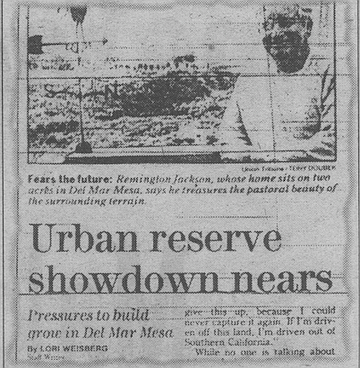 Facebook
Facebook
 X
X
 Instagram
Instagram
 TikTok
TikTok
 Youtube
Youtube
Norma S. Damashek’s thesis examines the “micropolitics” of San Diego: how the “growth machine” dominates local land use and how institutionally embedded practices, “routinely employed by city government,” facilitate the planning process. She uses the history of San Diego’s North City, from 1970 to 1995, as her case study. “It is a tale of how planning fails, time and time again.”
In the mid-’60s, San Diegans passed the Progress Guide and General Plan by popular vote. The intent: build a strong downtown core and minimize “urban sprawl,” especially in the city’s northerly sector. In 1990, the City Council initiated a process that opened up North City as a “Future Urbanizing Area” (FUA). Damashek remarks: “the initiation of the North City FUA planning process...was an indirect but unmistakable signal that growth management, long professed to be a guiding tenet in San Diego planning and politics, was now considered expendable.”
What followed became an example of how the “growth machine” works. “Growth is the essence of local politics,” argues Nico Calavita, “a land-based elite is generally able to legitimatize the ideology of growth and manipulate the planning process.” In North City, Damashek contends that the city government transformed into a “mechanism that advances and legitimizes the manipulation of land use for private interest profits.

“The city’s early attempts at managing growth through a development phasing process, as prescribed in the first General Plan, were immediately undermined by development forces,” Damashek continues, “and the following two decades of growth-management strategies, policies, regulations, and planning processes were routinely sabotaged.”
Efforts by community and environmental activists to reinstate growth management failed to halt the planning process in general, and in particular, a “premature phase shift initiative in 1994” that opened up the North City FUA for development.
Damashek cites three methods of the growth machine: (1) it persistently subverts public practices and procedures to control the planning process; (2) the process is twisted to legitimize growth and development interests (“in a cynical perversion...planning was instituted as a retroactive activity to legitimize extant development proposals and to justify foregone political decisions to approve these proposals”); (3) this subversion “undermines democratic principles by constricting public participation in the planning and regulation of local land use, creating an environment ripe for political abuse.”
And city planners? They occupied “a Kafkaesque world in which the services they provided were valued by the development industry...while their professional status and integrity were denigrated. By doing their job well, planners simultaneously facilitated growth-machine interests and their own impotence.”
Has planning traditionally been in the service of the growth machine? “The answer is yes. The institution of planning, abetted by planners who function within it, has been a coequal force in the institutional web that insulated and nourished the growth and development industry and validated developer-driven land use policy.”

Norma S. Damashek’s thesis examines the “micropolitics” of San Diego: how the “growth machine” dominates local land use and how institutionally embedded practices, “routinely employed by city government,” facilitate the planning process. She uses the history of San Diego’s North City, from 1970 to 1995, as her case study. “It is a tale of how planning fails, time and time again.”
In the mid-’60s, San Diegans passed the Progress Guide and General Plan by popular vote. The intent: build a strong downtown core and minimize “urban sprawl,” especially in the city’s northerly sector. In 1990, the City Council initiated a process that opened up North City as a “Future Urbanizing Area” (FUA). Damashek remarks: “the initiation of the North City FUA planning process...was an indirect but unmistakable signal that growth management, long professed to be a guiding tenet in San Diego planning and politics, was now considered expendable.”
What followed became an example of how the “growth machine” works. “Growth is the essence of local politics,” argues Nico Calavita, “a land-based elite is generally able to legitimatize the ideology of growth and manipulate the planning process.” In North City, Damashek contends that the city government transformed into a “mechanism that advances and legitimizes the manipulation of land use for private interest profits.

“The city’s early attempts at managing growth through a development phasing process, as prescribed in the first General Plan, were immediately undermined by development forces,” Damashek continues, “and the following two decades of growth-management strategies, policies, regulations, and planning processes were routinely sabotaged.”
Efforts by community and environmental activists to reinstate growth management failed to halt the planning process in general, and in particular, a “premature phase shift initiative in 1994” that opened up the North City FUA for development.
Damashek cites three methods of the growth machine: (1) it persistently subverts public practices and procedures to control the planning process; (2) the process is twisted to legitimize growth and development interests (“in a cynical perversion...planning was instituted as a retroactive activity to legitimize extant development proposals and to justify foregone political decisions to approve these proposals”); (3) this subversion “undermines democratic principles by constricting public participation in the planning and regulation of local land use, creating an environment ripe for political abuse.”
And city planners? They occupied “a Kafkaesque world in which the services they provided were valued by the development industry...while their professional status and integrity were denigrated. By doing their job well, planners simultaneously facilitated growth-machine interests and their own impotence.”
Has planning traditionally been in the service of the growth machine? “The answer is yes. The institution of planning, abetted by planners who function within it, has been a coequal force in the institutional web that insulated and nourished the growth and development industry and validated developer-driven land use policy.”